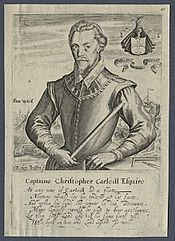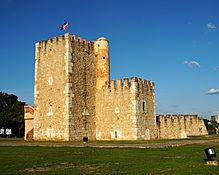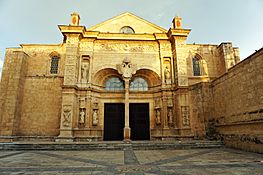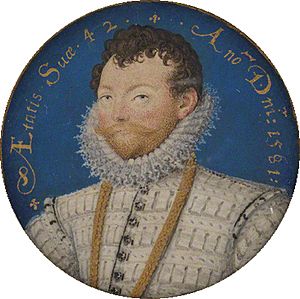Battle of Santo Domingo (1586) facts for kids
Quick facts for kids Battle of Santo Domingo (1586) |
|||||||
|---|---|---|---|---|---|---|---|
| Part of the Anglo–Spanish War | |||||||
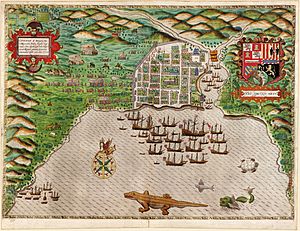 Sir Francis Drake in Santo Domingo 1585, hand-colored engraving, by Baptista Boazio, 1589 |
|||||||
|
|||||||
| Belligerents | |||||||
| Commanders and leaders | |||||||
| Cristóbal de Ovalle | Francis Drake Christopher Carleill |
||||||
| Strength | |||||||
| 1,400 soldiers and militia 100 cavalry 30 diverse warships, 1 galley |
23 ships 2,300 soldiers & sailors |
||||||
| Casualties and losses | |||||||
| 200 killed, wounded or captured, 1 galley sunk, 20 ships burned, 3 ships captured |
20 casualties 3 ships scuttled |
||||||
The Battle of Santo Domingo (1586) was an important fight during the Anglo-Spanish War. It happened on January 1, 1586. English soldiers and sailors, led by Francis Drake, attacked and captured the Spanish city of Santo Domingo. This city was on the island of Hispaniola, which is now part of the Dominican Republic.
Drake's attack was part of his "Great Expedition." He wanted to raid Spanish lands in the New World. The English took over the city for more than a month. They took many valuable items and received a large payment of 25,000 ducats before leaving on February 1.
Contents
Why the Battle Happened
War had already started between Spain and England. Philip II of Spain was angry because Elizabeth I of England supported the Dutch rebels. These rebels were fighting against Spanish rule in the Netherlands.
Queen Elizabeth I, through her advisor Francis Walsingham, told Sir Francis Drake to lead a trip to attack Spanish lands in the Americas. This was like a surprise attack to weaken Spain. Drake sailed from Plymouth, England. First, he attacked Vigo in Spain, holding it for two weeks and taking supplies. Then, in November 1585, he attacked Santiago in the Cape Verde Islands, taking its riches. After that, he sailed towards the Americas.
Drake reached the Caribbean in December. He stopped at the empty island of Saint Kitts to rest his sick crew and get supplies. From there, he sent a small group of ships to scout the Spanish city of Santo Domingo. Santo Domingo was the main city of Spain's empire in the New World. It had strong walls built in the early 1500s, including the Fortaleza Ozama and its tall Torre de Homenaje (Homage Tower).
The city's governor, Cristóbal de Ovalle, had many cannons to protect both land and sea. He also had nearly 1,500 soldiers, including 100 on horseback. The city's navy had one large ship called a galley. Even though it wasn't very good for sailing, it could still be a threat.
English Ships Arrive
As Drake sailed west, he met his scouting ships. They told him that Santo Domingo looked too strong to attack from the sea. But they had found a good landing spot at the mouth of the Haina River, about ten miles west of the city. Drake knew that the Spanish didn't expect his fleet to be there, so he had the element of surprise.
Just after midnight on January 1, 1586, Drake's fleet arrived near the Bajos de Haina. Christopher Carleill and his soldiers landed on the beach, which was not guarded. The path through the jungle leading to the city was also unprotected. The English soldiers marched forward.
Meanwhile, Drake's main fleet sailed ten miles along the coast to Santo Domingo. The Spanish quickly saw the danger. Soldiers gathered, and they started building defenses on the shore. Many townspeople began to leave the city. At the harbor entrance, three Spanish ships were sunk to block the way, but it was too late.
The Fight Begins
On New Year's Day, Drake's ships were near the harbor entrance, close enough for their cannons to reach. As the English ships got into position, Drake ordered his cannons to fire at the castle. The Spanish fired back, and one cannonball hit Drake's ship, the Elizabeth Bonaventure. But most of the Spanish shots missed. Drake told his ships to move closer. Soon, they were firing at the castle and the shore defenses, distracting the Spanish as Drake had planned.
The Attack
Carleill and 800 soldiers moved through the jungle towards the city. By noon, they could see Santo Domingo. Drake then sent men in boats to pretend to land from the sea. This was a trick to make the Spanish send troops to the shore. The Spanish sent soldiers on foot and horseback, with cannons, out of the city's two gates closest to the sea. They planned to face the sea, with their cavalry protecting their right side.
But just as they were getting into position, Carleill and his men burst out of the jungle. They formed two groups of 1,000 men, with flags flying and music playing. They appeared on the right side of the Spanish forces.
Cristobal de Ovalle, the governor, saw that his men would be cut off from the city. He quickly moved his troops to protect the city gates. His cavalry tried to threaten the English from the side and behind, using a herd of cattle for cover. However, Carleill placed his soldiers with long spears (pikemen) and muskets (musketeers) on all sides. The Spanish were forced back, and the cattle just ran into the jungle. Both English groups kept moving forward, even under heavy fire from Spanish cannons. A group of Spanish musketeers hiding by the road also tried to stop them but were quickly pushed back by English fire. Within half an hour, the English landing party reached the western walls of Santo Domingo. Most of the Spanish soldiers and local fighters were running away.
Taking the City
The western defenses of Santo Domingo had two gates: the main gate called Lenba, and a smaller one closer to the beach. At this point, only about 300 Spanish defenders were left, and most of them didn't have guns. Carleill ordered Sergeant-Major Powell to attack the smaller gate with a special team. Carleill himself led the rest of his men towards the Lenba gate.
Both English groups started running and charged with their long spears. After a fierce hand-to-hand fight, the Spanish were pushed through both gates and then scattered. After this, the English groups didn't face much serious fighting. The attackers didn't stop until the two English groups met in the main square.
The English were now inside the city. They started looking for Spanish troops in the streets, heading towards the Fortaleza Ozama. This was Santo Domingo's main defense. If it fell, the whole city would be lost. A small group of Spanish soldiers held out behind its walls. The rest of the city was captured without any more fighting. Governor Cristóbal de Ovalle ran away from the battle, leaving his wife behind. She became Drake's main hostage.
The fortress kept fighting until nightfall, still being bombed by the English from land and sea. But under the cover of darkness, the remaining soldiers in the fortress secretly left by boat. By dawn, the English flag was flying over the Torre de Homenaje, the tall tower inside the Fortaleza Ozama. The English secured their positions. The battle was over, and Santo Domingo was now in their hands. The attack had cost Carleill only seven soldiers killed and about twenty wounded. The Spanish losses were similar, but they had nearly 200 men captured.
Taking Control
Drake told his men to fix the city's defenses in case the Spanish tried to fight back. The harbor was also secured. More than twenty Spanish ships in the harbor were either taken or burned. English sailors and soldiers then started searching for valuable things. They targeted churches, stealing decorations, smashing statues and windows, tearing down religious tapestries, and damaging altars. Then they looted public buildings and took what they could from private homes.
They found a lot of goods, including food, wine, and tobacco. But they only found 16,000 gold ducats in the city's treasury. However, the main cathedral was saved from being destroyed. Drake used it as his headquarters, and prayers were said there to thank God for their victory.
Asking for Money
Drake knew the Spanish would want to pay money to save their city and the lives of the prisoners. On January 12, the city's chief judge, Juan Malarejo, met with Drake, and talks began. Drake demanded a huge amount: one million ducats. The governor said he could not possibly pay that much. Malarejo kept delaying the talks. As the discussions continued, Drake ordered public buildings and churches to be set on fire, one after another.
To put more pressure on Malarejo, Drake's men began to tear down the city's large stone buildings. This was very hard work for the English sailors.
The next Spanish person to negotiate was García Fernández de Torrequemada, a royal official. But Malarejo was very stubborn and disagreed with him. So Drake set fire to more buildings. He even threatened to destroy his own headquarters, which was the oldest church in all of the Americas. Finally, Malarejo offered a payment of 25,000 ducats.
The Payment
The deal was finally agreed upon. Drake promised to spare what was left of the city and sail away if the money was paid quickly. Drake sent a message to the Spanish camp with a young boy who had recently joined the English after being freed from slavery. However, the Spanish saw this as an insult and hurt the boy. This made Drake so angry that he ordered many Spanish prisoners to be executed until the person responsible was found. The Spanish agreed and brought the man to justice by hanging him in front of the city. The payment was finally made during the last days of January.
-
The Homage Tower at Fortaleza Ozama
-
Cathedral of Santa María la Menor at Santo Domingo; Drake used it as his headquarters during the occupation
What Happened Next
On February 1, the English sailed away from Santo Domingo. They had occupied the city for exactly one month. More than 20 ships in the harbor were burned or sunk. The Spanish galley ship was also burned. Drake took three Spanish ships to replace three of his own that were too damaged to sail. One of the largest captured ships was a 600-ton merchant ship, which the English renamed the New Years Gift. Two hundred and forty cannons and many goods were loaded onto the English ships. Their crews also grew with many freed galley-slaves.
About a third of Santo Domingo was in ruins. When the Spanish slowly returned, they found that all of its important city, military, and religious buildings had been destroyed. García Fernández de Torrequemada wrote to the King about how the people felt:
This thing must have had divine approval, as punishment for the people's sins.
As Drake left and headed south, news of his attack spread to other Spanish cities in the Americas. They were warned that the English might attack them next. Rumors soon reached Europe, and the Spanish received many confusing reports about what had happened. Pope Sixtus V commented about Drake's actions:
God only knows what he may succeed in doing.
It took many decades for Santo Domingo to recover from Drake's attack. For the Spanish, it was a big disaster and a blow to their pride. For the English, it was a huge boost to their spirits, both in England and among the fleet. Drake's next target was the city of Cartagena de Indias on the mainland of New Granada. Drake attacked and captured that city too, treating it similarly to Santo Domingo. Cartagena was better defended, and the payment for its safety was even larger.
See also
 In Spanish: Toma de Santo Domingo (1586) para niños
In Spanish: Toma de Santo Domingo (1586) para niños




